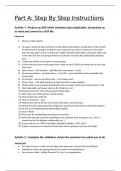Summary
Summary Pearson BTEC Level 3 Information Technology - Unit 2 Creating systems to manage information – Part A Step by Step Instructions – 2024
- Institution
- PEARSON (PEARSON)
This is the Pearson BTEC Level 3 Information Technology, Unit 2, part A step by step instructions. Covering all the criteria in detail with references included and was awarded a Distinction. With an easy to follow format and structure, guaranteed to help you get the best grade possible! Led me to r...
[Show more]



